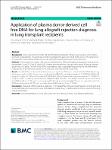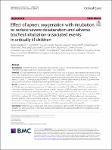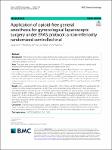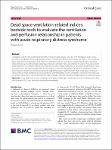Search
Author
- Daqing, Ma (3)
- Alexis, Ferré (2)
- Anna, Lybeck (2)
- Ashish K., Khanna (2)
- next >
Subject
- intensive care unit (8)
- acute respiratory dist... (5)
- chronic obstructive pu... (5)
- ICU (5)
- next >
Date issued
Has File(s)
Search Results
Ethylene glycol (EG) is metabolized into glycolate and oxalate and may cause metabolic acidemia, neurotoxicity, acute kidney injury (AKI), and death. Historically, treatment of EG toxicity included supportive care, correction of acid–base disturbances and antidotes (ethanol or fomepizole), and extracorporeal treatments (ECTRs), such as hemodialysis. With the wider availability of fomepizole, the indications for ECTRs in EG poisoning are debated. We conducted systematic reviews of the literature following published EXTRIP methods to determine the utility of ECTRs in the management of EG toxicity. |
During liver surgery and transplantation, periods of partial or total vascular occlusion are inevitable and result in ischemia-reperfusion injury (IRI). Nanomedicine uses the latest technology, which has emerged with interdisciplinary effects, such as biomedical sciences, physics, and engineering, to protect and improve human health. Interdisciplinary research has brought along the introduction of antioxidant nanoparticles as potential therapeutics. The goal of this study was to investigate the effects of cerium oxide (CeO2) administration and desflurane anesthesia on liver tissue in liver IR injury. |
Despite improvements in imaging and diagnostic procedures in critically ill patients presenting with organ failure, uncertainty often exists with regard to the exact diagnosis and a corresponding targeted therapy. Recent studies have demonstrated an error rate of up to 44% in diagnosis after autopsy [1]. The novel coronavirus disease 2019 (COVID-19)—especially the associated severe acute respiratory syndrome—led to a rush of critically ill patients to intensive care units, which were neither prepared in terms of staff and logistic demands nor in terms of specific knowledge of such a new disease. |
Donor-derived cell-free DNA (dd-cfDNA) has been applied to monitor acute rejection (AR) in kidney and heart transplantation. This study was aimed to investigate the application of dd-cfDNA levels in the diagnosis of AR and chronic lung allograft dysfunction (CLAD) among the lung transplantation recipients (LTRs). |
During the transition from paediatric to adult healthcare there is a gap between asthma guidelines and actual management with decreased healthcare consultations and dispensations of asthma medications after the transition to adult healthcare among young people with asthma. How health-related quality of life (HRQoL) develops during the transition from adolescence to young adulthood is unclear. Our aim was therefore to investigate HRQoL among young people with asthma during the transition to adulthood. Further, to assess if level of asthma control and physical activity influence any potential association between asthma and HRQoL. |
Spreading depolarization (SD) has been linked to the impairment of neurovascular coupling. However, the association between SD occurrence and cerebrovascular pressure reactivity as a surrogate of cerebral autoregulation (CA) remains unclear. Therefore, we analyzed CA using the long-pressure reactivity index (L-PRx) during SDs in patients with aneurysmal subarachnoid hemorrhage (aSAH). |
Determine if apneic oxygenation (AO) delivered via nasal cannula during the apneic phase of tracheal intubation (TI), reduces adverse TI-associated events (TIAEs) in children. |
Workers in pulp and paper factories are continuously exposed to paper dust. Excessive exposure to paper dust can cause respiratory disease. Information about the prevalence of chronic respiratory symptoms and dust exposure levels among workers in pulp and paper factories is not available in Ethiopia. The aim of this study was, therefore, to assess personal total dust exposure levels, the prevalence of chronic respiratory symptoms and their associated risk factors among workers in Ethiopian pulp and paper factories. |
Enhanced recovery after surgery (ERAS) is now widely used in various surgical fields including gynecological laparoscopic surgery, but the advantages of opioid-free anesthesia (OFA) in gynecological laparoscopic surgery under ERAS protocol are inexact. |
Cumulative evidence has demonstrated that the ventilatory ratio closely correlates with mortality in acute respiratory distress syndrome (ARDS), and a primary feature in coronavirus disease 2019 (COVID-19)-ARDS is increased dead space that has been reported recently. Thus, new attention has been given to this group of dead space ventilation-related indices, such as physiological dead space fraction, ventilatory ratio, and end-tidal-to-arterial PCO2 ratio, which, albeit distinctive, are all global indices with which to assess the relationship between ventilation and perfusion. |










